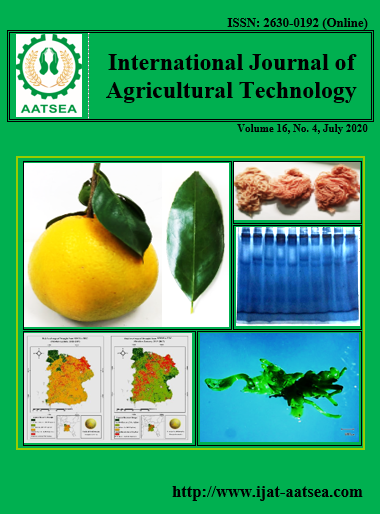Pathogenicity of Pyricularia oryzae on elite rice cultivars and geographical distribution of avirulence genes causing blast disease in Thailand
Main Article Content
Abstract
Pyricularia oryzae is a plant pathogenic fungus causing rice blast disease. In Thailand, there is very little information about pathogenicity and avirulence gene of rice blast pathogen. Each of the 50 blast isolates obtained from blast disease samples collected from 19 provinces was investigated for avirulence gene on 31 near isogenic lines (NILs) and their pathotype on elite rice cultivars was determined using 24 Thai elite rice cultivars. Among the 50 isolates, Avr-Pita-2 was discovered mostly in isolates from the North (83%), Avr-Pikp and Avr-Pi7(t) were discovered in isolates from the North East (94%), while 8 avirulence genes including Avr-Pikp, Avr-Pikh, Avr-Pi1, Avr-Pi7(t), Avr-Piz, Avr-Pi12, Avr-Pi19 and Avr-Pi20 were discovered in isolates from the South (88%) and Avr-Pi9 was discovered in isolates from the Central region of Thailand (71%). Isolates BRM60001 that carried the most numbers of Avr gene was unable to infect any elite rice cultivars, while isolates that carried as less as 2 Avr genes could infect few elite rice cultivars. Isolate CRI59004.1 carried Avr-Pik (Avr-Pikh, Avr-Pikm, Avr-Pi7(t)), Avr-Pi9, Avr-Pish, Avr-Pib, Avr-Piz-5, Avr-Pita, Avr-Pita-2 and Avr-Pi19, could infect the greatest numbers of elite rice cultivars. The information regarding the distribution of Avr gene in P. oryzae will be useful for forecasting rice blast and disease resistance breeding programs.
Article Details

This work is licensed under a Creative Commons Attribution-NonCommercial-NoDerivatives 4.0 International License.
References
Akator, S. K., Adjata, D. K., Hode, G. Y., Awande, S., Dieng, I., Sere, Y. and Yawovi, M. D. G. (2014). Cultural and pathological studies of Pyricularia oryzae isolates at Abomey Calavi in Benin. Plant Pathology Journal, 13:44-49.
Chakhonkaen, S., Pitnjam, K., Saisuk, W., Ukoskit, K. and Muangprom, A. (2012). Genetic structure of Thai rice and rice accessions obtained from the International Rice Research Institute. Retrived from: http://www.thericejournal.com/content/5/1/19.
Chiapello, H., Mallet, L., Guerin, C., Aguileta, G., Amselem, J., Kroj, T., Ortega-Abboud, E., Lebrun, M.H., Bernard Henrissat, B., Gendrault, A., Rodolphe, F., Tharreau, D. and Fournier, E. (2015). Deciphering genome content and evolutionary relationships of Isolates from the fungus Magnaporthe oryzae attacking different host plants. Genome Biology and Evolution, 7:2896-2912.
Chuwa, C. J., Mabagala, R. B. and Reubenet, M. S. O. W. (2013). Pathogenic variation and molecular characterization of Pyricularia oryzae, causal agent of rice blast disease in Tanzania. International Journal of Science and Research, 4:1131-1139.
Fukuta, Y., Koga, I., Ung, T., SATHYA, K., Tanaka, K. A., Koide, Y., Kobayashi, N., Obara, M., Yadana, H. and Hayashi, N. (2014). Pathogenicity of rice blast (Pyricularia oryzae Cavara) isolates from Cambodia. Japan Agricultural Research Quarterly, 48:155-166.
Gallet, R., Colin, F., François, B., Joëlle, M., Christophe, T., Henri, A., Virginie, R., Elisabeth, F. and Didier, T. (2015). Evolution of compatibility range in the rice−Magnaporthe oryzae system: an uneven distribution of R genes between rice subspecies. Phytopathology, 06:348-354.
Lei, C. L., Zhang, G. M., Cheng Z. J., Ma, J. T., Wang, J. L., Xin, A. H., Chen, P., Xiao, J. L., Zhang, X., Liu, Y. X., Guo, X. P., Wang, J., ZHAI, H. Q. and Wan, J. M. (2013). Pathogenic races and virulence gene structure of Magnaporthe oryzae population and breeding strategy for blast resistance in Heilongjiang province. Acta Agronomica Sinica, 7:18-27.
Liao, J., Huang, H., Meusnier, I., Adreit, H., Ducasse, A., Bonnot, F., Pan, L., He, X., Kroj, T., Fournier, E., Tharreau, D., Gladieux, P. and Morel, J. B. (2016). Pathogen effectors and plant immunity determine specialization of the blast fungus to rice subspecies. eLife, 5:1-8.
Lopez, A., Lopez, C., Matilla, Y. T. and Cumagun, C. J. R. (2019). Geographic distribution of avirulence genes of the rice blast fungus Magnaporthe oryzae in the Philippines. Microorganisms, 7:1-10.
Mekwatanakarn, P., Kositratana, W., Levy, M. and Zeigler, R. S. (2000). Pathotype and avirulence gene diversity of Pyricularia grisea in Thailand as determined by rice lines near-isogenic for major resistance genes. Plant Disease, 84:60-70.
Odjo, T., Tanaka, A. K., Noda, T., Ahohuendo, B. C., Sere, Y., Kumashiro, T., Yanagihara, S. and Yoshimichi F. (2014). Pathogenicity analysis of blast (Pyricularia oryzae cavara) isolates from West Africa. Japan Agricultural Research Quarterly, 48:403 - 412.
Prabhu, A. S., Filippi, M. C. and Castro, N. (1992). Pathogenic variation among isolates of Pyricularia oryzae affecting rice, wheat, and grasses in Brazil. Tropical Pest Management, 38:367-371.
Promsomboon, P. and Promsomboon, S. (2016). Collection and evaluation of local Thai rice varieties (Oryza sativa L.). Journal of Life Sciences, 10:371-374.
Roumen, E., M. Levy and J. L. Nottegham. (1997). Characterization of the European pathogen population of Magnaporthe grisea by DNA fingerprinting and pathotype analysis. European Journal in Plant Pathology, 103:363-371.
Sirithunya, P., Sreewongchai, T., Sriprakhon, S., Toojinda, T., Pimpisithavorn, S., Kosawang, C., and Smitamana, P. (2007). Assessment of genetic diversity in Thai isolates of Pyricularia grisea by random amplification of polymorphic DNA. Phytopathology, 156:196-204.
Sreewongchai, T., Sriprakhon, S., Wongsaprom, C., Vanavichit, A., Toojinda, T., Tharreau, D. and Sirithunya, P. (2009). Genetic mapping of Magnaporthe grisea avirulence gene corresponding to leaf and panicle blast resistant QTLs in Jao Hom Nin rice cultivar. Journal of Phytopatholgy, 157:338-343.
Saleh, D., Joelle, M., Henri, A., Elisabeth, F. and Didier, T. (2014). South-East Asia is the center of origin, diversity and dispersion of the rice blast fungus, Magnaporthe oryzae. New Phytologist, 201:1440-1456.
Wang, G. L. and Valent, B. (2009). Advances in genetics, genomics and control of rice blast disease, Springer Science Business Media, pp.430.
Xing, J., Jia, Y., Peng, Z. and Yinfeng, S. (2017). Characterization of molecular identity and pathogenicity of rice blast fungus in Hunan province of China. Plant Disease, 101:557-561.
Zeigler, R. S. (1998). Recombination in Magnaporthe grisea. Annual Review of Phytopathology, 36:249-275.


